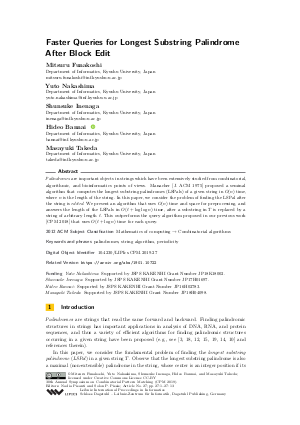Faster Queries for Longest Substring Palindrome After Block Edit
Authors
Mitsuru Funakoshi,
Yuto Nakashima,
Shunsuke Inenaga,
Hideo Bannai  ,
Masayuki Takeda
,
Masayuki Takeda
-
Part of:
Volume:
30th Annual Symposium on Combinatorial Pattern Matching (CPM 2019)
Part of: Series: Leibniz International Proceedings in Informatics (LIPIcs)
Part of: Conference: Annual Symposium on Combinatorial Pattern Matching (CPM) - License:
 Creative Commons Attribution 3.0 Unported license
Creative Commons Attribution 3.0 Unported license
- Publication Date: 2019-06-06
File

PDF
LIPIcs.CPM.2019.27.pdf
- Filesize: 0.67 MB
- 13 pages
Document Identifiers
Related Versions
Subject Classification
ACM Subject Classification
- Mathematics of computing → Combinatorial algorithms
Keywords
- palindromes
- string algorithm
- periodicity
Metrics
- Access Statistics
-
Total Accesses (updated on a weekly basis)
0PDF Downloads0Metadata Views
Abstract
Palindromes are important objects in strings which have been extensively studied from combinatorial, algorithmic, and bioinformatics points of views. Manacher [J. ACM 1975] proposed a seminal algorithm that computes the longest substring palindromes (LSPals) of a given string in O(n) time, where n is the length of the string. In this paper, we consider the problem of finding the LSPal after the string is edited. We present an algorithm that uses O(n) time and space for preprocessing, and answers the length of the LSPals in O(l + log log n) time, after a substring in T is replaced by a string of arbitrary length l. This outperforms the query algorithm proposed in our previous work [CPM 2018] that uses O(l + log n) time for each query.
Cite As Get BibTex
Mitsuru Funakoshi, Yuto Nakashima, Shunsuke Inenaga, Hideo Bannai, and Masayuki Takeda. Faster Queries for Longest Substring Palindrome After Block Edit. In 30th Annual Symposium on Combinatorial Pattern Matching (CPM 2019). Leibniz International Proceedings in Informatics (LIPIcs), Volume 128, pp. 27:1-27:13, Schloss Dagstuhl – Leibniz-Zentrum für Informatik (2019)
https://doi.org/10.4230/LIPIcs.CPM.2019.27
BibTex
@InProceedings{funakoshi_et_al:LIPIcs.CPM.2019.27,
author = {Funakoshi, Mitsuru and Nakashima, Yuto and Inenaga, Shunsuke and Bannai, Hideo and Takeda, Masayuki},
title = {{Faster Queries for Longest Substring Palindrome After Block Edit}},
booktitle = {30th Annual Symposium on Combinatorial Pattern Matching (CPM 2019)},
pages = {27:1--27:13},
series = {Leibniz International Proceedings in Informatics (LIPIcs)},
ISBN = {978-3-95977-103-0},
ISSN = {1868-8969},
year = {2019},
volume = {128},
editor = {Pisanti, Nadia and P. Pissis, Solon},
publisher = {Schloss Dagstuhl -- Leibniz-Zentrum f{\"u}r Informatik},
address = {Dagstuhl, Germany},
URL = {https://drops.dagstuhl.de/entities/document/10.4230/LIPIcs.CPM.2019.27},
URN = {urn:nbn:de:0030-drops-104989},
doi = {10.4230/LIPIcs.CPM.2019.27},
annote = {Keywords: palindromes, string algorithm, periodicity}
}
Author Details
Funding
- Nakashima, Yuto: Supported by JSPS KAKENHI Grant Number JP18K18002.
- Inenaga, Shunsuke: Supported by JSPS KAKENHI Grant Number JP17H01697.
- Bannai, Hideo: Supported by JSPS KAKENHI Grant Number JP16H02783.
- Takeda, Masayuki: Supported by JSPS KAKENHI Grant Number JP18H04098.
References
-
Amihood Amir, Panagiotis Charalampopoulos, Costas S. Iliopoulos, Solon P. Pissis, and Jakub Radoszewski. Longest Common Factor After One Edit Operation. In SPIRE 2017, pages 14-26, 2017.

- Amihood Amir, Panagiotis Charalampopoulos, Solon P. Pissis, and Jakub Radoszewski. Longest Common Factor Made Fully Dynamic. CoRR, abs/1804.08731, 2018. URL: http://arxiv.org/abs/1804.08731.
-
Alberto Apostolico, Dany Breslauer, and Zvi Galil. Parallel detection of all palindromes in a string. Theoretical Computer Science, 141:163-173, 1995.

-
Michael A. Bender and Martin Farach-Colton. The LCA Problem Revisited. In LATIN 2000, pages 88-94, 2000.

-
Michael A. Bender and Martin Farach-Colton. The Level Ancestor Problem simplified. Theor. Comput. Sci., 321(1):5-12, 2004.

-
Petra Berenbrink, Funda Ergün, Frederik Mallmann-Trenn, and Erfan Sadeqi Azer. Palindrome Recognition In The Streaming Model. In STACS 2014, pages 149-161, 2014.

-
O. Berkman and U. Vishkin. Finding level-ancestors in trees. J. Comput. System Sci., 48(2):214-230, 1994.

-
Martin Farach-Colton, Paolo Ferragina, and S. Muthukrishnan. On the sorting-complexity of suffix tree construction. J. ACM, 47(6):987-1011, 2000.

-
Mitsuru Funakoshi, Yuto Nakashima, Shunsuke Inenaga, Hideo Bannai, and Masayuki Takeda. Longest substring palindrome after edit. In CPM 2018, pages 12:1-12:14, 2018.

-
Pawel Gawrychowski, Tomohiro I, Shunsuke Inenaga, Dominik Köppl, and Florin Manea. Tighter Bounds and Optimal Algorithms for All Maximal α-gapped Repeats and Palindromes - Finding All Maximal α-gapped Repeats and Palindromes in Optimal Worst Case Time on Integer Alphabets. Theory Comput. Syst., 62(1):162-191, 2018.

-
Pawel Gawrychowski, Oleg Merkurev, Arseny M. Shur, and Przemyslaw Uznanski. Tight Tradeoffs for Real-Time Approximation of Longest Palindromes in Streams. In CPM 2016, pages 18:1-18:13, 2016.

-
Richard Groult, Élise Prieur, and Gwénaël Richomme. Counting distinct palindromes in a word in linear time. Inf. Process. Lett., 110(20):908-912, 2010.

-
Dan Gusfield. Algorithms on Strings, Trees, and Sequences. Cambridge University Press, 1997.

-
Roman Kolpakov and Gregory Kucherov. Searching for gapped palindromes. Theor. Comput. Sci., 410(51):5365-5373, 2009.

-
Dmitry Kosolobov, Mikhail Rubinchik, and Arseny M. Shur. Finding Distinct Subpalindromes Online. In PSC 2013, pages 63-69, 2013.

-
Glenn Manacher. A New Linear-Time "On-Line" Algorithm for Finding the Smallest Initial Palindrome of a String. Journal of the ACM, 22:346-351, 1975.

-
U. Manber and G. Myers. Suffix arrays: A new method for on-line string searches. SIAM Journal on Computing, 22(5):935-948, 1993.

-
W. Matsubara, S. Inenaga, A. Ishino, A. Shinohara, T. Nakamura, and K. Hashimoto. Efficient Algorithms to Compute Compressed Longest Common Substrings and Compressed Palindromes. Theor. Comput. Sci., 410(8-10):900-913, 2009.

-
Alexandre H. L. Porto and Valmir C. Barbosa. Finding approximate palindromes in strings. Pattern Recognition, 35:2581-2591, 2002.

-
Yuki Urabe, Yuto Nakashima, Shunsuke Inenaga, Hideo Bannai, and Masayuki Takeda. Longest Lyndon Substring After Edit. In CPM 2018, pages 19:1-19:10, 2018.

-
Peter Weiner. Linear Pattern Matching Algorithms. In 14th Annual Symposium on Switching and Automata Theory, pages 1-11, 1973.

